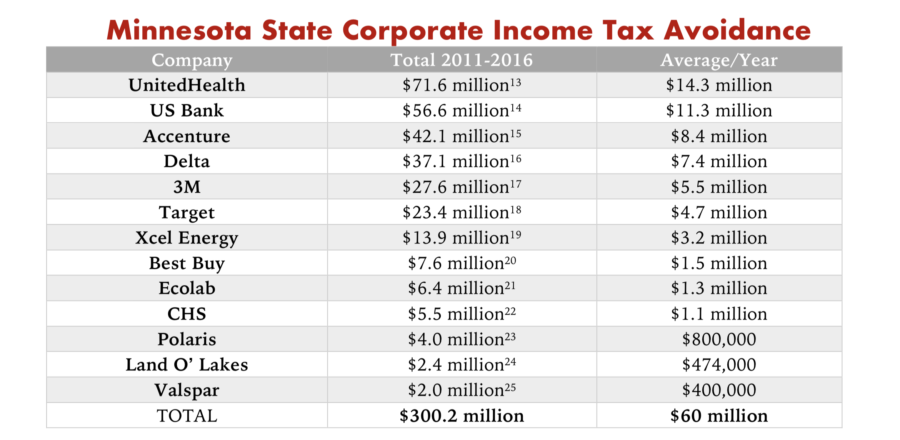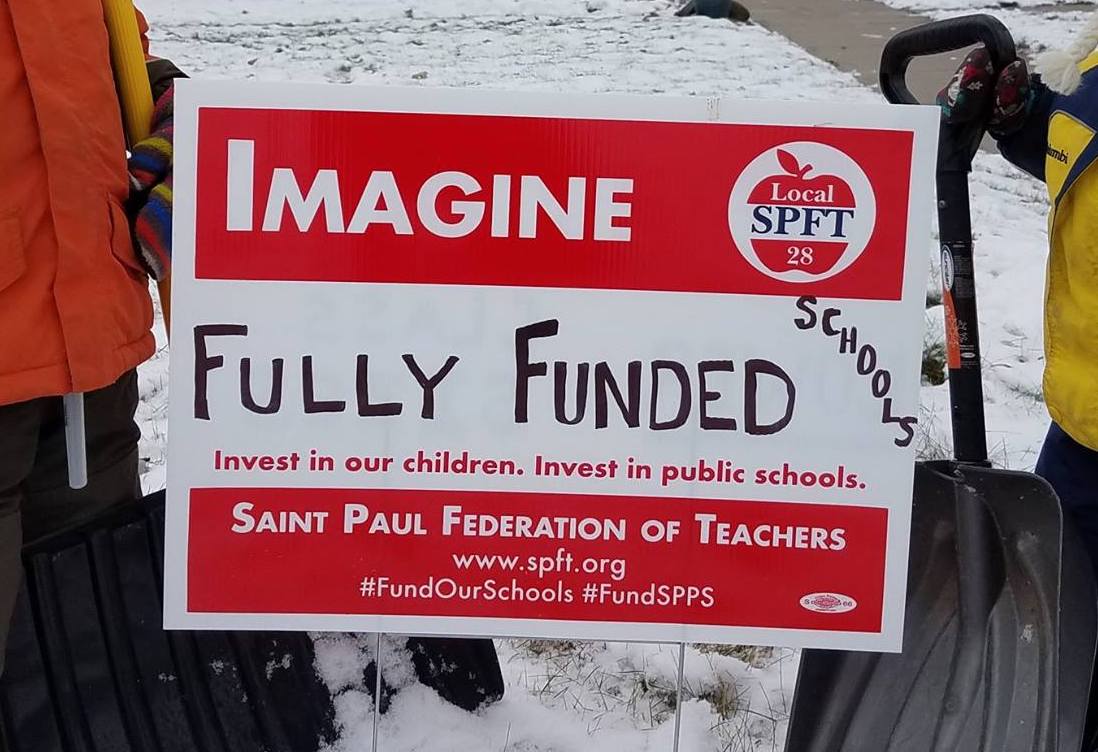 School districts across the nation have been hammered by relentless budget cuts for almost a decade. Even today, as the economy improves and massive tax giveaways to the wealthiest are a top legislative priority, public schools are still told that the well is dry, and key programs and positions must be once again slashed to close deficits.
School districts across the nation have been hammered by relentless budget cuts for almost a decade. Even today, as the economy improves and massive tax giveaways to the wealthiest are a top legislative priority, public schools are still told that the well is dry, and key programs and positions must be once again slashed to close deficits.
The 3,700 members of the Saint Paul Federation of Teachers (SPFT), however, are not willing to accept austerity as reality. With contract negotiations around the corner in 2018, the educators in this 40,000-student district served notice that finding new revenue streams - notably pressuring the city's wealthiest corporations to pay their fair share - was on the bargaining table.
That St. Paul schools needed more money was not in dispute. In the 2017-18 school year, the district faces a projected budget shortfall of more than $27 million. State aid has lagged behind inflation, class sizes have increased, key positions such as nurses and ELL teachers have been cut, and new programs with proven track records, such as restorative justice practices, were being squeezed out. For a district with large numbers of English-language learners, homeless students, and students eligible for free and reduced lunch, the inability of funding to keep up with student needs has had severe consequences.
As bargaining got underway, the district insisted that there just wasn't any money for these programs.
But St. Paul educators were having none of it. The money to help restore funding could be found in the massive tax breaks, loopholes, and subsidies granted to corporations and the property taxes private colleges and major non-profits don't have to pay.
"Scarcity is a myth," said SPFT president Nick Faber. "Tax avoidance by some of the wealthiest members of our community is depriving schools of tens of millions of dollars."
With an expanded bargaining team that included school and community service professionals, educational assistants, and teachers, SPFT offered 10 proposals in bargaining, developed after meetings with parents and community stakeholders, including smaller class sizes, expanding restorative practices, adding more support staff for students in special education programs, and increasing support for English-Language Learners. SPFT also asked the district to collaborate on a joint effort to lobby for changes in state tax policy, negotiate with corporations and other entities on larger voluntary payments to schools, and partner on a property tax referendum for the November 2018 ballot.
The union's decision to merge broader funding and equity issues with more bread-and-butter concerns in the negotiating process was seen as a bold and groundbreaking move. Educators however were refusing to be limited - "pidgeonholed" says Faber - to negotiating over wages and benefits.
 Source: 'Sacked: How Corporations on the Super Bowl Host Committee Left Minnesota’s Public Schools Underfunded and Under Attack' (St. Paul Federation of Teachers, 2017)
Source: 'Sacked: How Corporations on the Super Bowl Host Committee Left Minnesota’s Public Schools Underfunded and Under Attack' (St. Paul Federation of Teachers, 2017)
Rejecting Business as Usual
With the district sticking to its austerity script, tense and combative contract negotiations led to a standstill by late January. On January 31, SPFT voted to strike for the first time in St. Paul since 1989 if an agreement was not met in a week. After eight straight days of mediated talks, a settlement was reached and the strike was called off.
St. Paul educators came away with clear wins, securing additional staff and other supports for ELL and special education students, new class size measures, and expansion of the restorative practices program.
District officials also promised to explore “joint agreements” with large corporations and wealthy medical and higher education non-profits, lobby for education funding together on a state and federal level, and examine the possibility of the referendum.
A Case Against Working People
A handful of greedy CEOs and special interests don’t want educators to have a seat at the table to advocate for better schools and the resources their students need. Learn about Janus v AFSCME, a case that looks to divide and limit unions members’ collective bargaining power.
While the district didn't commit to any one specific new funding proposal, SPFT's success at elevating the issue - along with protecting language around class size and restorative justice - marked a victory for "bargaining for the common good," a thriving, if not altogether new, approach to bargaining and organizing that expands the playing field to focus on equity, social justice, and other community-wide concerns.
Using collective bargaining to build a larger movement has been at the forefront of SPFT's organizing for years, and the recent contract campaign only solidified its position as a national leader in this brand of unionism.
Rejecting "business as usual" and calling attention to the scarcity myth around school funding was the lynchpin in the union's strategy as it geared up for contract negotiations in 2017.
"If we really want to insure that we have equitable schools in St. Paul, we have to bring more money into the district," said Jenna Styles Spooner, a kindergarten teacher at Riverview Elementary. "Corporations paying their fair share is one way this could be achieved."
Over the five years she has been in the classroom, Styles Spooner has witnessed firsthand how budget cuts have affected her teaching and her students. In her first year, she and her colleagues benefitted from support provided by coaches in the district Office of Early Learning (OEL) to help implement a new kindergarten curriculum.
By her second year, budget cuts had weakened the program, triggering an exodus of coaches - positions that haven't been refilled. "The impact on the early learners in our district has been great," said Styles Spooner.
"What it boils down to is us being less able to meet our students' needs, especially those most vulnerable or already underserved in our community," she added. "The needs of our students are only increasing while our funds are decreasing."

'The Message is Resonating'
Minnesota is a rich state and its largest corporations pay lower rates for state income and state property taxes than they did in the previous decade. Corporations also pad their pockets through off shore accounts and other loopholes in the tax code.
The egregious catering to business interests at the expense of local communities is a nationwide and longstanding problem. State and local governments give away at least $70 billion a year to business subsidies, most of it in foregone tax revenue.
St. Paul is also host to an abundance of major non-profits and private colleges who are also shielded from property tax laws. Almost one-third of the property in the city is tax exempt because it is owned by non-profits or government entities.
Local property taxes are the most significant tax most corporations pay and are the backbone of local school finance, supplying almost a third of the budgets for K-12 education.
If we really want to insure that we have equitable schools in St. Paul, we have to bring more money into the district. Corporations paying their fair share is one way this could be achieved" - Jenna Styles Spooner, teacher
In December, SPFT released a report calling attention to these tax avoidance practices to coincide with the hype surrounding the 2018 Super Bowl, hosted next door in Minneapolis. “Sacked: How Corporations on the Super Bowl Host Committee Left Minnesota’s Public Schools Underfunded and Under Attack” is a primer on the various schemes – aided and abetted by local and state law – Big Business deploys to reap huge financial gains while contributing less and less to the community.
From the beginning of the contract campaign, St. Paul educators forged strong partnerships with parents and community members - a pillar of a "common good" campaign - so that their input was used to formulate the bargaining demands. The bargaining sessions were open to the public.
SPFT also assembled a group of parents, educators, and community members in a group called the TIGER Team (Teaching and Inquiring about Greed, Equity, and Racism) that is tasked with investigating how money has been taken away from public schools to support private interests and what can be done to reverse the trend. TIGER team members have given presentations to different community groups, school site councils and parent organizations, and groups of educators.
SPFT representatives also met with Ecolab, U.S. Bank and other beneficiaries of property-tax breaks to discuss possible common ground. Unsurprisingly, the union's requests were met with polite indifference.
Still, bargaining for the common good is a long-term strategy and SPFT have built alliances that will only strengthen as educators and district officials set out to explore generating more revenue for their schools.
"The message is resonating," said Faber. "We have enough money in our state to fully fund public schools. We just have to have the courage and the will to bring it back to our students. "


